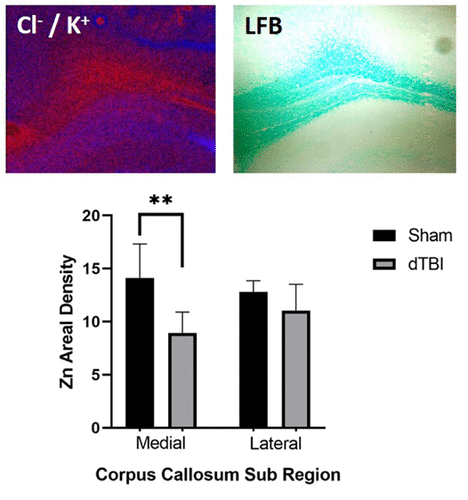当前位置:
X-MOL 学术
›
ACS Chem. Neurosci.
›
论文详情
Our official English website, www.x-mol.net, welcomes your
feedback! (Note: you will need to create a separate account there.)
Characterization of Ionic and Lipid Gradients within Corpus Callosum White Matter after Diffuse Traumatic Brain Injury in the Rat.
ACS Chemical Neuroscience ( IF 4.1 ) Pub Date : 2020-01-13 , DOI: 10.1021/acschemneuro.9b00257 David Hartnell 1, 2 , Kate Gillespie-Jones 3 , Cristina Ciornei 3 , Ashley Hollings 1, 2 , Alexander Thomas 1, 2 , Elizabeth Harrild 1, 2 , Juliane Reinhardt 4, 5 , David J Paterson 4 , Dasuni Alwis 3 , Ramesh Rajan 3 , Mark J Hackett 1, 2
ACS Chemical Neuroscience ( IF 4.1 ) Pub Date : 2020-01-13 , DOI: 10.1021/acschemneuro.9b00257 David Hartnell 1, 2 , Kate Gillespie-Jones 3 , Cristina Ciornei 3 , Ashley Hollings 1, 2 , Alexander Thomas 1, 2 , Elizabeth Harrild 1, 2 , Juliane Reinhardt 4, 5 , David J Paterson 4 , Dasuni Alwis 3 , Ramesh Rajan 3 , Mark J Hackett 1, 2
Affiliation

|
There is increased recognition of the effects of diffuse traumatic brain injury (dTBI), which can initiate yet unknown biochemical cascades, resulting in delayed secondary brain degeneration and long-term neurological sequela. There is limited availability of therapies that minimize the effect of secondary brain damage on the quality of life of people who have suffered TBI, many of which were otherwise healthy adults. Understanding the cascade of biochemical events initiated in specific brain regions in the acute phase of dTBI and how this spreads into adjacent brain structures may provide the necessary insight into drive development of improved therapies. In this study, we have used direct biochemical imaging techniques (Fourier transform infrared spectroscopic imaging) and elemental mapping (X-ray fluorescence microscopy) to characterize biochemical and elemental alterations that occur in corpus callosum white matter in the acute phase of dTBI. The results provide direct visualization of differential biochemical and ionic changes that occur in the highly vulnerable medial corpus callosum white matter relative to the less vulnerable lateral regions of the corpus callosum. Specifically, the results suggest that altered ionic gradients manifest within mechanically damaged medial corpus callosum, potentially spreading to and inducing lipid alterations to white matter structures in lateral brain regions.
中文翻译:

大鼠弥漫性外伤性脑损伤后Corp体白色物质中离子和脂质梯度的表征。
人们对弥漫性颅脑损伤(dTBI)的影响的认识得到提高,它可以引发未知的生化级联反应,从而导致继发性继发性脑退化和长期神经系统后遗症。治疗方法的可用性有限,无法最大程度地减少继发性脑损伤对TBI患者的生活质量的影响,其中许多患者原本都是健康的成年人。了解dTBI急性期在特定大脑区域启动的生化事件的级联及其如何扩散到相邻的大脑结构中,可能为驱动改良疗法的发展提供必要的见识。在这项研究中,我们已经使用直接生化成像技术(傅立叶变换红外光谱成像)和元素映射(X射线荧光显微镜)来表征在dTBI急性期call体白质中发生的生化和元素变化。结果提供了相对脆弱的call体外侧区域相对高度脆弱的内侧call体白质中发生的差异生化和离子变化的直接可视化。具体而言,结果表明改变的离子梯度在机械损伤的内侧体中出现,可能扩散到脑外侧区域的白质结构并诱导脂质改变。结果提供了相对脆弱的call体外侧区域相对高度脆弱的内侧call体白质中发生的差异生化和离子变化的直接可视化。具体而言,结果表明改变的离子梯度在机械损伤的内侧体中出现,可能扩散到脑外侧区域的白质结构并诱导脂质改变。结果提供了相对脆弱的call体外侧区域相对高度脆弱的内侧call体白质中发生的差异生化和离子变化的直接可视化。具体而言,结果表明改变的离子梯度在机械损伤的内侧体中出现,可能扩散到脑外侧区域的白质结构并诱导脂质改变。
更新日期:2020-01-13
中文翻译:

大鼠弥漫性外伤性脑损伤后Corp体白色物质中离子和脂质梯度的表征。
人们对弥漫性颅脑损伤(dTBI)的影响的认识得到提高,它可以引发未知的生化级联反应,从而导致继发性继发性脑退化和长期神经系统后遗症。治疗方法的可用性有限,无法最大程度地减少继发性脑损伤对TBI患者的生活质量的影响,其中许多患者原本都是健康的成年人。了解dTBI急性期在特定大脑区域启动的生化事件的级联及其如何扩散到相邻的大脑结构中,可能为驱动改良疗法的发展提供必要的见识。在这项研究中,我们已经使用直接生化成像技术(傅立叶变换红外光谱成像)和元素映射(X射线荧光显微镜)来表征在dTBI急性期call体白质中发生的生化和元素变化。结果提供了相对脆弱的call体外侧区域相对高度脆弱的内侧call体白质中发生的差异生化和离子变化的直接可视化。具体而言,结果表明改变的离子梯度在机械损伤的内侧体中出现,可能扩散到脑外侧区域的白质结构并诱导脂质改变。结果提供了相对脆弱的call体外侧区域相对高度脆弱的内侧call体白质中发生的差异生化和离子变化的直接可视化。具体而言,结果表明改变的离子梯度在机械损伤的内侧体中出现,可能扩散到脑外侧区域的白质结构并诱导脂质改变。结果提供了相对脆弱的call体外侧区域相对高度脆弱的内侧call体白质中发生的差异生化和离子变化的直接可视化。具体而言,结果表明改变的离子梯度在机械损伤的内侧体中出现,可能扩散到脑外侧区域的白质结构并诱导脂质改变。







































 京公网安备 11010802027423号
京公网安备 11010802027423号